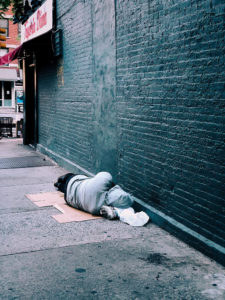Back to School? LGBTQ+ Youth Homelessness
 Photo by Jon Tyson on Unsplash
Photo by Jon Tyson on Unsplash As the summer winds down and back-to-school season begins, public focus increases on funding for schools, teachers, and resources. While enrollment in public schools for children between the ages of six and sixteen is mandatory in the United States (with some exceptions), a significant population of children are unable to attend—the LGBTQ+ youth population experiencing homelessness.
On any day in any city in the United States, there are 3,800 youth experiencing homelessness. These fifteen to twenty-four year olds often work on the streets, sleep in bus terminals and train stations, and do whatever they can to survive, often getting roped into criminal activities like drug dealing or prostitution due to their vulnerable status. Out of the population of homeless youth, about 40 percent identify as LGBTQ+ or questioning—a staggeringly high number considering only about 7 percent of the total population of youth in the United States identify as LGBTQ+. LGBTQ+ youth are 120 percent more likely to experience homelessness than the wider American youth population. Once kicked out, these young people are much more likely to be refused access to care or discriminated against, usually for the same reason they left home in the first place: intolerance of their sexual orientation or gender identity or expression, often for religious reasons.
Many queer youth experiencing homelessness come from strong religious backgrounds. Struggling to reconcile their religious beliefs and their sexuality, they encounter institutionalized prejudice, administrative indifference, verbal abuse, and outright violence in schools as well as lack of support at home, leading them to leave home in search of a supportive environment where they feel accepted and loved. However, adult caretakers are mandated to place youth under the age of sixteen in foster care, where over 70 percent are victims of violence within their foster homes, are removed from foster care, or run away due to conflicts over their sexual orientation or gender identity. Lack of support in foster care leads these queer youth to the streets, and then, when they seek shelter, the only places that will accept them on short notice are shelters run by faith-based organizations.
In such shelters, youth who present differently from the average resident are easy targets for discrimination and violence, both from staff and other youth. Because churches offer affordable rental space, many homeless shelters, food pantries, and soup kitchens operate out of them. However homophobia and transphobia run rampant, often aided by un- or undertrained staff. Church-run shelters, which pride themselves on their work caring for the poor and providing safe spaces for those less fortunate, often kick youth out if they discover they’re queer, perpetuating the same cycle that forced these teenagers out on the street in the first place. Some of these young people even report that sex work is a safer option than going to a faith-based organization.
Despite lack of funding, awareness, and institutional support from federal, state, and local governments, some supportive, individualized alternatives to these discriminatory shelters exist and continue to save lives, including the Ruth Ellis Center in Detroit, Michigan, CHRIS Kids in Atlanta, Georgia, and Casa Ruby in Washington, DC. In New York City, the Ali Forney Center, New Alternatives, Sylvia’s Place, Housing Works, and Hetrick-Martin Institute all provide shelter, meals, job training, educational opportunities, addiction harm reduction, medical care, and safe spaces for these youth. Targeted specifically toward LGBTQ+ youth, these shelters focus on first getting the youth off the streets and addressing their mental health needs while showing them the respect and dignity they deserve.
The Ali Forney Center provides youth with emergency beds and, eventually, their own apartments, giving them responsibility and preparing them for productive adult lives. New Alternatives is a drop-in center for some of the most marginalized youth in New York City, running support groups, providing balanced meals, helping obtain IDs and driving teens to medical appointments. Housing Works provides a range of services, including street outreach and clinics to get medical care to the most inaccessible youth. Hetrick-Martin Institute runs both an alternative school for LGBTQ+ teenagers as well as afterschool drop-in programs to get youth off the streets. These alternative organizations’ services and approaches, though varied, often serve the same clientele and are focused on the same goals: to care for the youth who need it the most, to begin reversing the abuse these teenagers suffered elsewhere, and to accept and affirm the myriad of identities that cross their doorsteps., These alternative shelters show youth and the surrounding communities that regardless of sexual orientation or gender identity, all people deserve access to safe spaces to live and thrive.
On the heels of International Youth Day (August 12) and as young people return to school, we should take some time to think about—and advocate for—these frequently overlooked, extremely vulnerable people. For too long, LGBTQ+ youth homelessness has been a lower priority for the LGBTQ+ community in the United States. But protecting children and ensuring they grow up safe, happy, well fed, and without threat of violence is something the whole world can agree on. With awareness-raising efforts, advocacy for federal, state, and local funding for LGBTQ+ shelters, and training for social workers and shelter staff, humanists can do so much better for these young people.
